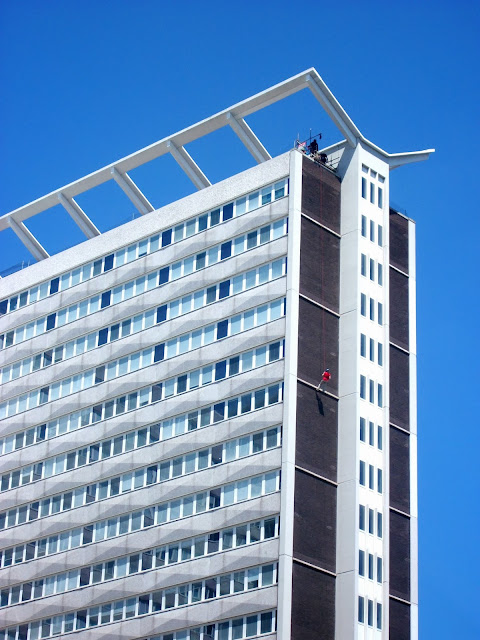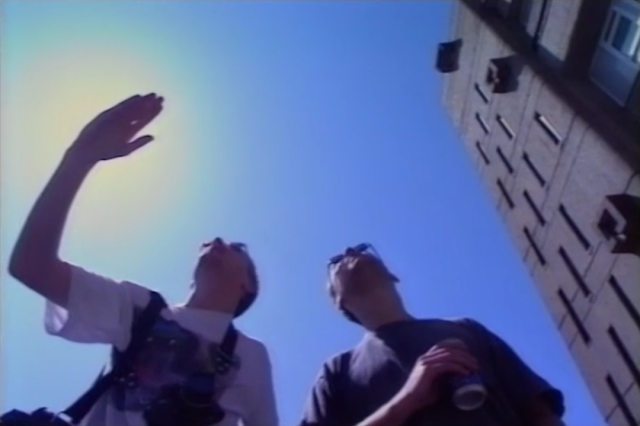Drowning in Berlin
The small brass studs in the pavement weren't obvious, and it was only on our third trip to the high street that we noticed them. Adam and I were staying in a flat in Wedding, north Berlin, a sprawling residential district made up of large five storey blocks dating from the late nineteenth century to the postwar period. The brass studs were clustered around the doorways of a number of the blocks on Ostender Strasse. They listed a few bare details: Here lived, each began, following with name, date and the fate of the person: all the plaques on Ostender Strasse held the details of people transported from Berlin in 1943. the destination for most of them was listed too: Auschwitz. These studs buried in the floor are called stolpersteins. Stumbling blocks. They commemorate victims of the Holocaust. There were two outside one house, three outside another, another two further down. I'd never seen stolpersteins before, never even heard of them. For such modest memorials, their impact is incredible. I've not stopped thinking about them since.
We soon discovered that the stolpersteins were just the beginning of the groundworks we'd find. In the city centre we noticed another memorial buried into the ground. There was a slim line of cobbles crossing roads, pavements and parks. This was the Berlin Wall memorial, tracing the route of the 1961 boundary built between East and West Berlin.
Then there were the actual sections of the wall still standing, some between Checkpoint Charlie and Potsdamer Platz, others forming folk art shrine the East Side Gallery. And then there were many patches of urban wasteland dotted about the city, gaps where bombs had fallen, buildings had collapsed, the rubble and remains quite overgrown. The sheer amount of wilderness in the city centre was startling. In London every inch is being monetised, between factory units, on awkward triangles of lawn, right to the edge of the railway lines. In Berlin space and history rules. And this is despite the almost absurd amount of building work that is going on. We took a Trabant Safari round the city, chasing our guide through traffic in an army-green East German car, the engine screaming away, even at the most modest of speeds. Our Spanish guide was laughing at the sheer number of building sites opening every day. Routes that had been clear the day before were now blocked by cones and diggers. Whole areas of the city centre were blocked off for major construction projects.
One of the strangest of these was on the banks of the Spree, on Museum Island. Once this site had held the Stadtschloss, the City Palace: a vast lump of Prussian baroque. Bomb damage made repair a vastly expensive proposition for the new East German authorities, and instead they demolished it, and replaced it with The Palace of the Peoples, an equally huge modernist structure, opened in 1976. It was the seat of the East German parliament, and also included a huge amount of public space, from restaurants to bowling alleys, a theatre and a disco, rather like the public spaces in the new regional parliaments springing up. It also housed hundreds of modernist chandaliers, lighting the place up like a sun. As conveniently as bomb damage had allowed the Schloss to be demolished by the East Germans, so asbestos allowed the reunified city authorities to gut the communist palace, thus leading to its inevitable demolition a decade ago. And now what is there? Why, it's a replica of the Schloss, of course! Great concrete slabs are being lifted into place to be covered with a baroque facade, while the inside is envisaged as a modern gallery space: the Humboldtforum. It is a project of embarrassing silliness, and does justice to neither the original baroque palace, or the modernist one that had stood in its place. This Matt Frei documentary explores the story rather brilliantly.
Our guide book wasted no opportunity to slag the East German TV Tower as a piece of ugly, kitch rubbish, while also rating it as the highest must-see in the entire book. Denial can be a ridiculous thing. It's clearly amazing, both as a landmark and as a visitor attraction. The view is incredible, the disco-ball stylings of the main pod is peerless, and the silhouette from anywhere in the city is a piece of pure theatre, enhancing any view. Even the base, a mixture of Angry Birds cheeping mouths, b-movie spaceship landing ramps and 1971 Croydon Whitgift Centre baulstrades, is a thing of wonder.
The west's modernist counterpart to the tower, the Palace of the Republics and the wall in the east, is situated in the Tiergarten, at the Hansaplatz station. This is Interbau, housing built for the 1957 international architecture exhibition. Like the Lansbury Estate in East London, built for the Festival of Britain, this was an exhibition designed to be lived in. Here everyone from Walter Gropius to Alvar Aalto had a go at designing state of the art modernist buildings, from point blocks to bungalows, slab blocks to churches. The buildings themselves are beautifully kept. It's hard not to be charmed by the v-shaped legs on Oscar Niemeyer's flats, or the bright panels on the tower block designed by Jo van den Broek and Jacob Bakem. We saw a white wedding proceeding on horeseback to one of the churches, accompanied by the sonorous clanging of bells, and there were wild rabbits hopping about near the nettles that surrounded Alvar Aalto's modernist houses. It's not on the main tourist trail, perhaps, but I'd recommend a visit. It's quiet, there's loads of public seating, you're on the edge of the Tiergarten and the Spree, and the buildings are bloody wonderful.
We soon discovered that the stolpersteins were just the beginning of the groundworks we'd find. In the city centre we noticed another memorial buried into the ground. There was a slim line of cobbles crossing roads, pavements and parks. This was the Berlin Wall memorial, tracing the route of the 1961 boundary built between East and West Berlin.
Then there were the actual sections of the wall still standing, some between Checkpoint Charlie and Potsdamer Platz, others forming folk art shrine the East Side Gallery. And then there were many patches of urban wasteland dotted about the city, gaps where bombs had fallen, buildings had collapsed, the rubble and remains quite overgrown. The sheer amount of wilderness in the city centre was startling. In London every inch is being monetised, between factory units, on awkward triangles of lawn, right to the edge of the railway lines. In Berlin space and history rules. And this is despite the almost absurd amount of building work that is going on. We took a Trabant Safari round the city, chasing our guide through traffic in an army-green East German car, the engine screaming away, even at the most modest of speeds. Our Spanish guide was laughing at the sheer number of building sites opening every day. Routes that had been clear the day before were now blocked by cones and diggers. Whole areas of the city centre were blocked off for major construction projects.
One of the strangest of these was on the banks of the Spree, on Museum Island. Once this site had held the Stadtschloss, the City Palace: a vast lump of Prussian baroque. Bomb damage made repair a vastly expensive proposition for the new East German authorities, and instead they demolished it, and replaced it with The Palace of the Peoples, an equally huge modernist structure, opened in 1976. It was the seat of the East German parliament, and also included a huge amount of public space, from restaurants to bowling alleys, a theatre and a disco, rather like the public spaces in the new regional parliaments springing up. It also housed hundreds of modernist chandaliers, lighting the place up like a sun. As conveniently as bomb damage had allowed the Schloss to be demolished by the East Germans, so asbestos allowed the reunified city authorities to gut the communist palace, thus leading to its inevitable demolition a decade ago. And now what is there? Why, it's a replica of the Schloss, of course! Great concrete slabs are being lifted into place to be covered with a baroque facade, while the inside is envisaged as a modern gallery space: the Humboldtforum. It is a project of embarrassing silliness, and does justice to neither the original baroque palace, or the modernist one that had stood in its place. This Matt Frei documentary explores the story rather brilliantly.
Our guide book wasted no opportunity to slag the East German TV Tower as a piece of ugly, kitch rubbish, while also rating it as the highest must-see in the entire book. Denial can be a ridiculous thing. It's clearly amazing, both as a landmark and as a visitor attraction. The view is incredible, the disco-ball stylings of the main pod is peerless, and the silhouette from anywhere in the city is a piece of pure theatre, enhancing any view. Even the base, a mixture of Angry Birds cheeping mouths, b-movie spaceship landing ramps and 1971 Croydon Whitgift Centre baulstrades, is a thing of wonder.
The west's modernist counterpart to the tower, the Palace of the Republics and the wall in the east, is situated in the Tiergarten, at the Hansaplatz station. This is Interbau, housing built for the 1957 international architecture exhibition. Like the Lansbury Estate in East London, built for the Festival of Britain, this was an exhibition designed to be lived in. Here everyone from Walter Gropius to Alvar Aalto had a go at designing state of the art modernist buildings, from point blocks to bungalows, slab blocks to churches. The buildings themselves are beautifully kept. It's hard not to be charmed by the v-shaped legs on Oscar Niemeyer's flats, or the bright panels on the tower block designed by Jo van den Broek and Jacob Bakem. We saw a white wedding proceeding on horeseback to one of the churches, accompanied by the sonorous clanging of bells, and there were wild rabbits hopping about near the nettles that surrounded Alvar Aalto's modernist houses. It's not on the main tourist trail, perhaps, but I'd recommend a visit. It's quiet, there's loads of public seating, you're on the edge of the Tiergarten and the Spree, and the buildings are bloody wonderful.
There's a feeling of trauna to Berlin that resonates everywhere: from
the stolpersteins to the ruins of the Wall and the ghostly watch-towers;
the stasi museums and the Topography of Terror exhibit; the gap sites
and ruins; the new builds and memorials to past tragedies. Reading Hans
Fallada's astonishing wartime novel Alone in Berlin in an
apartment block similar to the one he bases the main action of the book
in, and having just read Eugen Ruge's equally moving story of East
German life, In Times of Fading Light, perhaps I just saw what I
wanted to see. A panorama of history, trauma and scars everywhere,
rather than a beautiful and proud European city getting on with
modernising itself after yet another bout of huge social change brought
about by reunification. I'd love to spend more time there again in future
to try to get my head around it. Not that that is possible, of
course. The one thing I was sure of when leaving was that despite an
air of calm and space, Berlin is overwhelming because everything feels
significant. Even the cobbles beneath your feet are trying to tell you
something.























Comments
Post a Comment